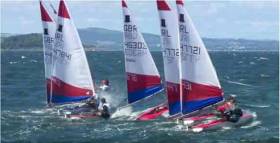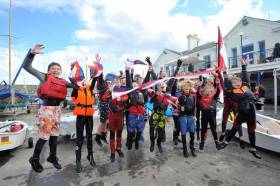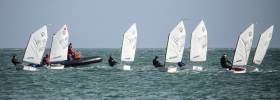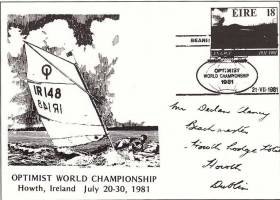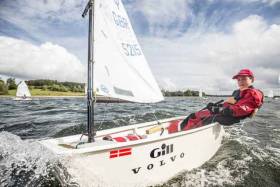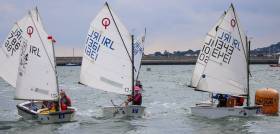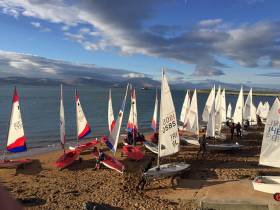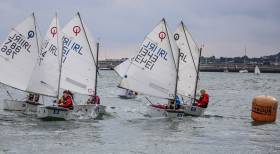Displaying items by tag: Optimist
With four days of an intensive programme getting under way tomorrow (Thursday) on three different course areas off Ballyholme Bay on Belfast Lough, the ISA Youth Sailing Nationals is making a spectacular debut in Northern Ireland writes W M Nixon.
The north in general, and Ballyholme in particular, have produced so many talented sailors that it seems surprising this is the first time the vibrant Ballyholme club, or indeed any club north of the border, has hosted the Youth Nationals in their contemporary guise.
But last summer’s successful Topper Worlds 2016 on Belfast Lough, and before that the F18 Worlds, have clearly shown that Ballyholme’s strong dinghy participation emphasis can confidently transfer itself into superb race management. And they’re certainly pulling out all the stops to deal with a total fleet numbers which should top the 250 mark by the time entries are finalised tomorrow tonight.
Yet even with entries finalised, it’s keeping pace with the new names in the rapid turnover of super-sailors in the junior divisions which test any analysis system. When you’ve a situation where you’re no longer a Youth Sailor after the age of 19, things happen very quickly. And though they’ll allow you to race a Topper at any old age you like (and some do), you’re only in the racing game if you’re under 16, while Optimists draw the serious line at 15, and all classes have further age sub-divisions.
Still and all, we’ll be looking forward to a real ding-dong in the Lasers between Johnny Durcan of Cork and Ewan MacMahon of Howth, who were first and second in last weekend’s 125-boat Munster Laser Championship at Baltimore. Let battle commence.
The ISA add:
Starting tomorrow Ireland’s largest Youth Sailing regatta is the ISA’s primary talent spotting event. The first time the event is being held at Ballyholme Yacht Club and it has over 200 sailors registered – the largest entry ever.
Racing will be held over three race courses and five classes. Organsiers say there will be great racing on the water and good fun at the club ashore.
Evening talks as well as the races are open to all young sailors who sail in the five ISA Youth Pathway Classes (Laser Radial, Laser 4.7, 420, Topper, Optimist).
The ISA squad programmes will resume this summer in the Laser 4.7 and Topper classes, and these classes will have a squad trial to identify future ISA Pathway sailors. In addition, ISA spotters are out to assess sailors for Academy trials for the Laser Radials and 420s. (The Optimists will have separate Class-organised talent spotters).
Eight places on the ISA Topper Squad : In the Topper class up to eight sailors will be selected to join the ISA Topper Squad. The Squad coach and programme will be announced following the event. The programme aimed at developing young Topper sailors will provide training and also support at the 2017 Topper World Championship to be held in Brittany, France in July. Entry to the World championship is independent of ISA squad selection and through the International Topper Class Association.
Five places on the ISA Laser 4.7 Squad: Up to five sailors will be chosen at the ISA Youth Pathway Nationals to join the ISA 4.7 Squad. A further two sailors may be chosen at the 2017 Laser 4.7 Ulster Championship. The ISA 4.7 squad will provide training to help young sailors transition in the Laser 4.7 class. It will also aim to prepare and support the squad for the Laser 4.7 World Championship to be held in Nieuwpoort, Belgium in July. The squad coach and programme will be announced following event. Entry to the 4.7 Worlds is independent of ISA squad selection through the International Laser Class Association.
At 5.30pm each evening there will be a talk and Q&A session at the Ballyholme Yacht Club with speakers who have a deep knowledge of racing. The talks are open to all sailors and parents.
Full list of Evening Speakers:
Wednesday 19th April, BILL O'HARA will discuss “What to consider when preparing for an event - Rules Strategy for racing”. Bill is the current Principal Race Officer for the Volvo Ocean Race, International Umpire and Rules adviser to the Irish Olympic Team.
Thursday 20th April, MATTY MC GOVERN (Double Olympian 49er Class) will talk on “Team Work in Sailing – Preparing a Professional Approach”
Friday 21st April, ANNALISE MURPHY (Olympic Silver medalist) will share her insights in a talk entitled “Beat the Best: Preparing for Competitive Gains at the Olympics”.
Saturday 22nd April, Ross Killian & Russell McGovern (ISA Performance Coaches) will give video analysis and coaching tips from the day’s racing.
National Yacht Club Junior Sailors Celebrate Links to Olympic Silver Medal & America’s Cup
A very special Golden Jubilee coming up in May provides links to an Irish Olympic Sailing Silver Medal, the Fireball World Championship, and the America’s Cup. W M Nixon finds the widest connections go even further than that to include a pioneering world voyage.
It was in May 1967 that the irrepressible Carmel Winkelmann oversaw the first results of a junior sailing initiative at the National Yacht Cub, her home club in Dun Laoghaire. It became a movement which went on which to have nationwide and worldwide ramifications, so much so that within Ireland we’re looking at an unbroken line in Irish sailing which is continued through the club which currently holds the title of ISA Training Centre of the Year, which for 2017 is Foynes Yacht Club on the Shannon Estuary.
That a successful club at the heart of the Atlantic seaboard can trace an almost magic thread back to something which happened at a club on Dublin Bay a long time ago is quite a story in itself. Particularly when the Atlantic seaboard club itself is imbued, as Foynes is, with the spirit of legendary circumnavigator Conor O’Brien. However, when the story is shaping up to continue with the Golden Jubilee as the latest chapter, it gives us an opportunity both to celebrate, and take stock of what it has all meant.
 Foynes Yacht Club, heirs to an Irish tradition of junior sail training which was first formalized by the National Yacht Club 50 years ago. At the Irish Sailing Awards ceremony when Foynes were announced as winners of the ISA Training Centre of the Year Award were (left to right) Simon McGibney (Foynes Senior Instructor), Sailor of the year and Olympic Silver Medallist Annalise Murphy of the National Yacht Club, Elaine O’Mahoney (Foynes Sailing Academy Manager), Pat Finucane (Sailing Academy Principal) and Conor Dillon (Instructor). In a club which is imbued with the spirit of world-girdling Foynes sailor Conor O’Brien, it’s particularly appropriate that Conor Dillon’s sailing CV includes winning the Two-Handed division in the Round Ireland Race, sailing with his father Derek Dillon on a 34-footer. Photo: Inpho
Foynes Yacht Club, heirs to an Irish tradition of junior sail training which was first formalized by the National Yacht Club 50 years ago. At the Irish Sailing Awards ceremony when Foynes were announced as winners of the ISA Training Centre of the Year Award were (left to right) Simon McGibney (Foynes Senior Instructor), Sailor of the year and Olympic Silver Medallist Annalise Murphy of the National Yacht Club, Elaine O’Mahoney (Foynes Sailing Academy Manager), Pat Finucane (Sailing Academy Principal) and Conor Dillon (Instructor). In a club which is imbued with the spirit of world-girdling Foynes sailor Conor O’Brien, it’s particularly appropriate that Conor Dillon’s sailing CV includes winning the Two-Handed division in the Round Ireland Race, sailing with his father Derek Dillon on a 34-footer. Photo: Inpho
But business first. Anyone who has ever taken part in the Junior Training Programme at the National Yacht Club is hereby alerted – if you don’t know already – that on the evening and night of Saturday May 20th, there will be a very special celebration at the clubhouse. The organisers Carmel Winkelmann and Ann Kirwan are particularly keen to trace those who have moved away, but would find much nostalgic pleasure with the meeting of old friends by returning on this day of days. So if that applies to you, or you know anyone to whom it does, please make contact with the key club administrator whom everyone refers to as “Oonagh at the National”, the proper line of contact being [email protected], tel 01-280 5725.
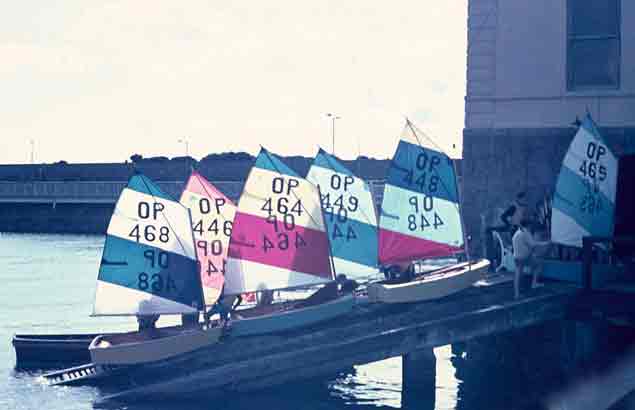 Bright morning of Optimism. The National Yacht Club slipway in 1967, long before the days of an extensive front-of-club platform, with the new dinghies of the Optimist Class being launched out of the cramped boathouse under the club, and down a steep and often very crowded slipway
Bright morning of Optimism. The National Yacht Club slipway in 1967, long before the days of an extensive front-of-club platform, with the new dinghies of the Optimist Class being launched out of the cramped boathouse under the club, and down a steep and often very crowded slipway
To grasp the significance of what is being celebrated, please try to visualize the National Yacht Club as it was fifty years ago. The building itself, standing directly in the harbour, has the air of a fishing lodge in the West of Ireland on its seaward side, and a hint of neo-classicism when seen from the town. But in the early 1960s it was very limited in its shoreside facilites for sailing dinghies. There was a boathouse entered through fine granite arches under the clubhouse itself, but to use it, masts needed to be lowered. It was served by a very steep and easily-crowded slip, while there was access to another slip on the east side of the cub which served a small area where dinghies could be stored. But while there was space for the established classes of Fireflies and some IDRA 14s, some room was also needed for the small tenders for larger yachts moored in the harbour, while the racing keelboats were served by club launches which might be substantial dinghies driven by vintage Seagull outboards.
The concept of a proper dinghy park was still only in its infancy, relatively speaking, for craft such as Dun Laoghaire’s Firefly and IDRA fleets which had been active since the late 1940s. Thus if anyone had a centreboard boat which could reasonably be expected to lie to moorings, she was obliged to do so, and the fleet of small craft lying off the club included the 17ft Mermaids and the 14ft Water Wags.
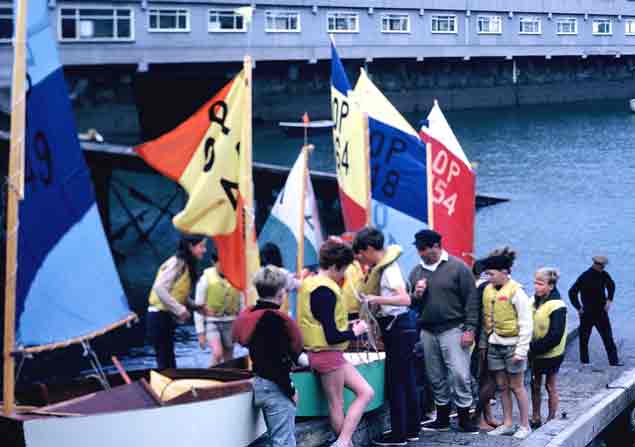 It could get very crowded on that steep slipway. Paddy Kirwan at the centre of a group making do with limited facilities
It could get very crowded on that steep slipway. Paddy Kirwan at the centre of a group making do with limited facilities
To compound the space problems afloat and ashore, during the 1960s the area in the southeast part of Dun Laoghaire Harbour off the National Yacht Club was the focal point for the cross-channel ferry berths. The railway-system serving Mailboat with its emphasis on foot passengers continued to use the Carlisle Pier to the west of the club, but the East Pier was known for a period as the Car Ferry Pier as a busy new roll-on roll-off terminal, which admittedly always had a temporary look about it, had been constructed there to accommodate the new trend in cross-channel travel.
Thus not only was anyone sailing a dinghy from shore at the National YC dong so out of decidedly limited facilities, but they immediately sailed into an area cluttered with a collection of moored boats of all shapes and sizes, and that in turn was set in an area which might have ferry ships berthed close by, or manoeuvring on either side.
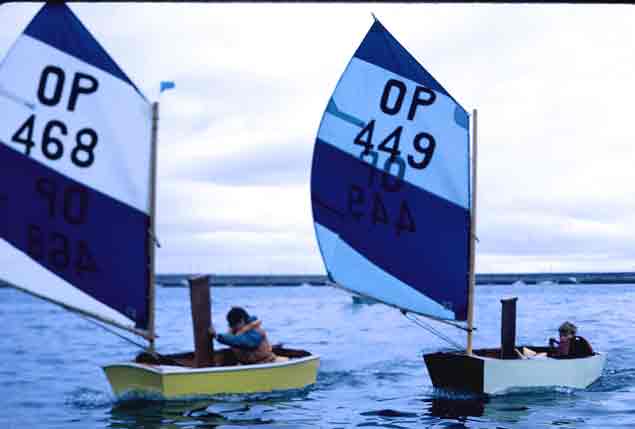 Learning curve. Gina Duffy and John Lavery on a close run in 1967. The latter has won many major championships, including the Fireball Worlds in 1995
Learning curve. Gina Duffy and John Lavery on a close run in 1967. The latter has won many major championships, including the Fireball Worlds in 1995
The comparisons with today’s National Yacht Club with its spacious platform facing out over a much clearer harbour area, and beside it an installation of convenient berthing pontoons, could not be greater. But back in the 1960s, an equally important change was happening – there was a complete re-appraisal of what the most junior sailors really needed in boats and instruction to get the best from the sport.
For sure there were the Fireflies, but in terms of lower age limit they were really aimed at adolescents on the cusp of rapidly growing youth. The other available classes were even more adult-oriented. In fact, the underlying problem was that children going sailing were treated as miniature adults who would somehow pick up the skills of the game through a sort of osmosis, whereas for a crucial period of their lives they would have most benefitted from being treated as a different species, with different boats to meet their needs.
Yet even here, adult views dominated. The grown-ups thought that young people’s boats should at least look like small yachts. Thus a dinghy which was promoted for children by several clubs was the 11ft Yachting World Cartop Heron, which had originally been conceived as a DIY-build which could fit on the roof-rack of the average family car, and was designed with a gunter rig such that all its spars could be stowed within the boat.
It had some good ideas, and with a pretty sheer it fulfilled the adult expectation of what a miniature yacht should look like. But it was surprisingly heavy for its avowed rooftop requirement – you’d have needed a weight-trained family to get it on the car roof. And anyway, it was too large for really small kids who genuinely had the sailing bug.
 The southeast corner of Dun Laoghaire Harbour was very different in 1967, with the East Pier re-designated as the Car Ferry Pier. Yet despite the limitations, the Optimist class quickly caught on after its introduction in 1967
The southeast corner of Dun Laoghaire Harbour was very different in 1967, with the East Pier re-designated as the Car Ferry Pier. Yet despite the limitations, the Optimist class quickly caught on after its introduction in 1967
So a revolutionary approach was needed, and it came thanks to one of the National YC’s international sailing stars, Johnny Hooper. He had achieved Ireland’s first Olympic Race win with Peter Gray in the Flying Dutchman in the 1960 Rome Olympics when the sailing was at Naples. But as an FD campaign towards the 1984 Olympics was prohibitively expensive with the venue in Japan, he returned to his first love of International 505 Racing, and it was at a big 505 championship in Scandinavia in 1965 or thereabouts that he first became aware of the game-changing possibilities of the Optimist for junior sailing.
Scandinavia being rightly renowned for the elegance of its yacht, it speaks volume for the versatility of the Florida-originating Optimist, the “simple little boxboat that sails surprisingly well”, that Scandinavia should lead the movement towards a world body for a boat which, whatever the traditionalists might think, the kids were clearly loving. Founded 1965, the International Optimist Dinghy Association (IODA) had Viggo Jacobsen of Denmark as its first President with his wife Edith as Secretary, and in that same year Johnny Hooper set about introducing the idea of the Optimist to Ireland.
Now if some ordinary Joe had happened to by impressed by an Optimist at some foreign location, and had even brought one home to persuade his fellow sailors that they were looking at the future, the idea probably would have fallen very flat indeed.
But that’s not the Hooper way. Instead, from his highly respected position he quietly targeted fellow National Yacht Club members who were themselves active sailors, but also had children who would benefit from the Optimist experience, and in time a group emerged which was to include initially Johnny Hooper with his wife Bernie giving the longterm involvement, Peter Gray, Paddy & Barbara Kirwan , Don Douglas, Franz & Carmel Winkelmann, Michael McGrath, Arthur Lavery and several others, many of whom had reasonable DIY skills and could see the possibility of building an Optimist in the basement of their Dun Laoghaire homes without too much disruption of the household. By the Autumn of 1966, the project was under way.
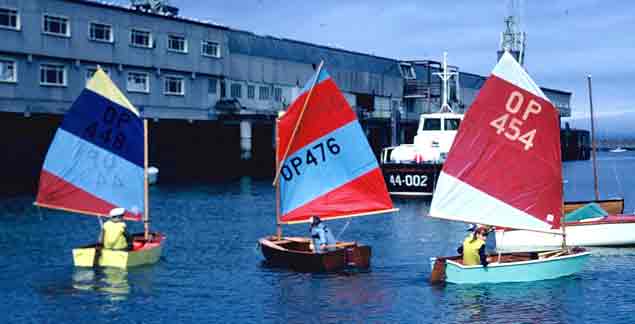 The first of the new fleet sails. Paddy Boyd (left) Ann Kirwan (centre) and Vivienne Lavery right) getting to know their boats
The first of the new fleet sails. Paddy Boyd (left) Ann Kirwan (centre) and Vivienne Lavery right) getting to know their boats
While Johnny Hooper had introduced the idea, he stood back from its continuing implementation, for the Hooper modus operandi was to give an idea enough strength to soon have wings of its own. That certainly happened in the National Yacht Club, for very quickly a manageably small committee was in being, and the formidable Carmel Winkelmann became its secretary. The NYC Junior Programme became her baby, and it always has since been seen as such, even though the number of people involved in administering the programme over the fifty years, as the NYC facilities have expanded and developed to meet the needs of a modern membership, will now run into the hundreds.
In fact, properly organized junior sailing with boats specifically designed for young people’s needs is now so central to Irish sailing that it takes a huge leap of the imagination to visualize the scene as the first small group of National Yacht Club Optimist Dinghies – most of them locally-built either by amateurs or professonals – began to emerge in May 1967 with numbers increasing as each weekend passed. New they may have been, but they reflected their era, with a public Blessing of the Boats outside the Brindley household as a new batch of boats appeared.
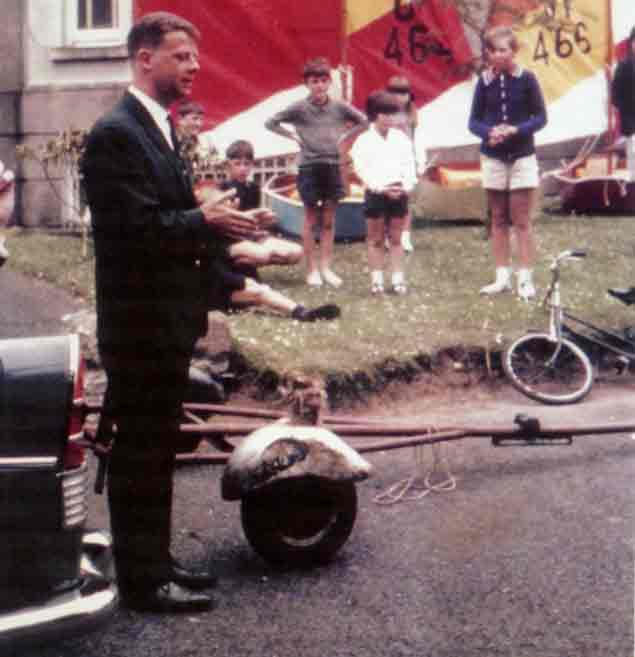 Olympic sailor Johnny Hooper speaking at the Blessing of the Boats as a new batch of home-built Optimists awaits transfer to the National’s limited space.
Olympic sailor Johnny Hooper speaking at the Blessing of the Boats as a new batch of home-built Optimists awaits transfer to the National’s limited space.
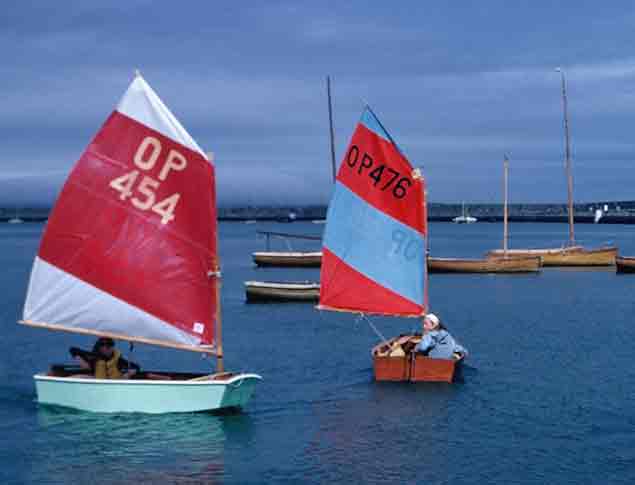 Dun Laoghaire was a different place in those days, with Water Wags and Mermaids expected to lie to mooring. Vivienne Lavery and Ann Kirwan testing their skills with the new Optimists – Ann’s boat (476) was one of the few professionally-built in the first batch of Optimists, she was created by the legendary Skee Gray
Dun Laoghaire was a different place in those days, with Water Wags and Mermaids expected to lie to mooring. Vivienne Lavery and Ann Kirwan testing their skills with the new Optimists – Ann’s boat (476) was one of the few professionally-built in the first batch of Optimists, she was created by the legendary Skee Gray
But though most young sailors in theory had his or her own boat, before anything approaching full fleet numbers was approached they’d a habit of letting anyone sail some boat or other in the early stages, so much so that although Ann Kirwan was part of it from a very early stage, she admits that even she can’t claim total accuracy when identifying the helm of a known boat.
 Going abroad......the new Dun Laoghaire Optimists make their debut at Bray Regatta: Paul, Adam and Lucy Winkelmann with Paddy Kirwan putting in his renowned act as a South American Air Marshall at Bray Sailing Club.
Going abroad......the new Dun Laoghaire Optimists make their debut at Bray Regatta: Paul, Adam and Lucy Winkelmann with Paddy Kirwan putting in his renowned act as a South American Air Marshall at Bray Sailing Club.
This habit of inter-changing sailors became even more marked in that first year when the early class discovered that the most useful base for their day-time sailing was the little-used Irish Lights service barge moored in the western part of the harbour. Over there, NYC Optimist sailors found much clearer sailing water, and they were well away from the comings and goings of the two cross-channel ferries off their home club, not to mention excessive parental control. In effect, the barge became their day-time base, and they ate their packed lunches aboard it while deciding who would take which boat for the first stage of the afternoon’s sailing. Fifty years down the line, we might well wonder if the Commissioners of Irish Lights are aware of the key role their humble barge played in launching Ireland’s Junior Training Programme.....
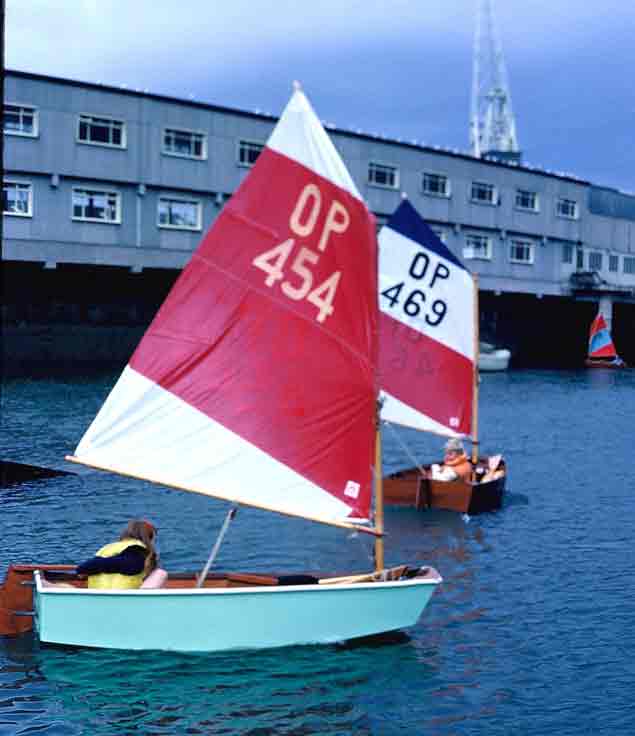 Vivienne Lavery and David Ryan getting away from the slip.
Vivienne Lavery and David Ryan getting away from the slip.
Once launched in its viable form in 1967, there was no stopping it, and the names which have emerged just from the National’s junior programme alone (for virtually all clubs now have one) take us over an extraordinary range, and up to the heights of Olympic participation, the winning of major world dinghy championships and associations with the America’s Cup.
It’s Johnny Smullen who provides the latter. The California-based Johnny Smullen in San Diego is now of world stature in anything to do with yacht and boat-building or indeed in marine construction generally, and his talent has been recognized at the highest level as he has worked on major projects for the very demanding Dennis Conner, aka Mr America’s Cup.
Johnny will have inherited his feeling for classics from his father Cass, a great sailor who was such an enthusiast for the Dublin Bay 21s in their original rather spectacular gaff-rigged form that when the class contemplated changing to a more easily-handled and convenient Bermudan rig in 1963, Cass claimed that he could easily rig a gaff-rigged DB 21 in 15 minutes flat. And that included setting the jackyard topsail to perfection. So he brought a DB 21 close into the clubhouse (as you could in those days), and in front of a drink-sipping crowd of observers on the verandah, he did the job within 15 minutes. But they still went ahead and converted to Bermudan rig.
Son Johnny meanwhile was enlisted in the NYC Junior Programme as soon as he reached he lower age limit, and when the 40th Anniversary was being celebrated back in 2007, he sent on his memoirs which well capture the flavour of it all:
San Diego, 17th May 2007
The way I saw it.
I am eight years old and my parents are wondering what to do with me for the summer, it went something like this: “Get him out from under our feet”. I was equally happy to stay at home and play in the back garden, invent stuff and dream up ways to frighten my sisters. Chasing them with worms was a good one.
I was enrolled in the adventure of my life.
At first I was lead to believe it was going to be a fun thing with the opportunity to meet new people and friends, maybe making me more sociable as I was quiet child in a world of my own. I bought into this and showed up for the first day. It was great, lots of people all different shapes and sizes, so there we were all sitting around playing with stuff and one-upping on how my father is better than yours, especially at snooker. The chatter fell silent when along came this very tall white-haired lady with an incredibly loud voice. It was at this point I became suspicious as I had just watched Paths of Glory and A Bridge Too Far, I had seen how the enemy rounded up people and put them in trucks and brought to places, unfriendly places.....
We arrived at Sandycove harbour where we were lined up on the pier. I though this was it, we were then forced to line up at the steps and walk down into the freezing water fully clothed and flail around, there were guards (instructors we were led to believe) everywhere, and just to make sure the torture was effective they made us hold our heads under water for 30 minutes, well 30 seconds, but it felt like minutes. Then we were all forced to walk back to the NYC where our fate was to be determined. Freezing and scared, I was cursing my family and wondering what I had done to them.
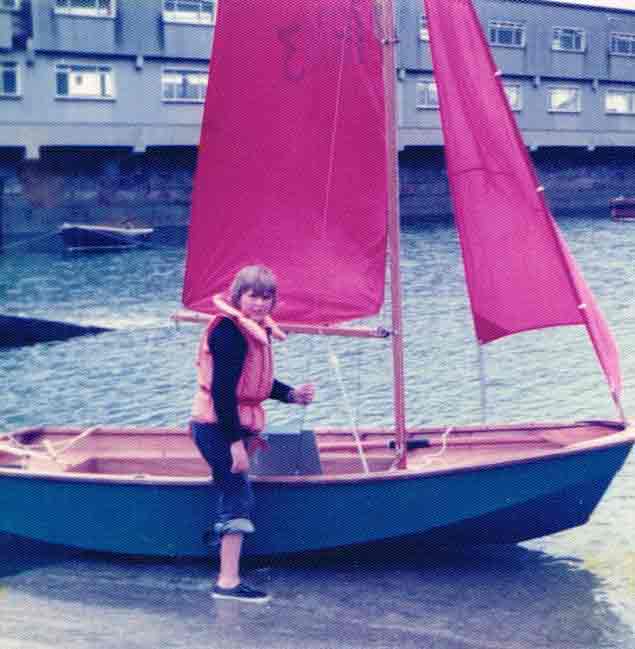 He survived.....eventually Johnny Smullen became a keen Mirror dinghy sailor, but he was pessimistic enough to call his boat Splinter
He survived.....eventually Johnny Smullen became a keen Mirror dinghy sailor, but he was pessimistic enough to call his boat Splinter
We arrived back at Camp NYC and were lined up and made to wear large cumbersome protective coats, some were yellow, purple, some orange, I guessed they were labelling us, something to do with our religion. Some of these jackets had large protective collars probably to help protect us from the beatings to come, I thought. Our names were branded onto the “Life Jackets” as I started to call them, knowing they would play a key role in our protection.
We were divided into groups and lead away by the guards into this large damp room with arches and a dank smell of cotton, hemp and mould. This was where we were to remain for all the rainy days to be brain-washed, they started by teaching us knots. I was convinced this was going to be how to tie the very knot that would be the doom of us, I compared it to carrying the cross of Calvary. I decided then to be really bad at it in the hopes that one of my knots would slip open and I could dash to my freedom. We also had to jump up, and hand-over-hand along the light blue steel beam that ran across the dark room, this was to make our arms really strong, they had a plan for strong arms – I will tell you about that a little later.
Food consisted of a march up to Wimpeys for a spice burger and chips all drowned in vinegar to disguise the taste, if there was good behaviour we got to go to the Miami Café. The day was long (except Thursdays when we had to get out early) and after a week in Boot Camp we were all tired and weary. What had I done to my family to deserve this?
The second week came along and we were introduced to the ships, rather large wooden craft resembling a landing craft with the flat bow (I was always looking for the hinges). This is where the strong arms came into. We were grouped into six per team, and the guards waited until low tide when we had to carry the ship down a rickety wooden slip (there’s a reason for calling it a slip). Upon its surface there were large wooden rollers but we were forbidden to use those rollers, and to make sure they filed a fat spot on the rollers, deeming them useless. We picked up the incredible heavy boat, all six of us, one on each corner holding a knee, and two in the middle by the oar locks. Later I was to learn the place to be was up at the bow (by the door), it was lightest. I was adapting to this cruel camp. As we descended down to the icy water again fully clothed, we came across a bright green pungent slime. I had what I thought were special sailing shoes, but as soon as I touched the slime I was down. Down hard. The guards started yelling, I knew I had to get up quickly....remember Calvary!....We reached the bottom and stopped, the guards yelled again and made us wade right into the icy deep, still fully clothed. With the landing craft now floating, we had to master manoeuvring, the craft were lined up alongside the slippy slip, that’s the reason they call it a..................
I stepped on the gunwhale. Now at this point I did not understand the physics like I do today, and when you apply a load to any point of the gunwhale of a flat-bottomed craft two things will happen (once only). The opposing gunwhale will come up as you travel down, and because I am as tall as the craft is wide, somewhere in the middle he two surfaces will meet, your face and the opposing gunwhale. After the initial shock, the second shock comes from the icy cold water. Then I found out what the large collar was for as the guards hauled me out of the abyss semi-conscious. Once inside the craft, we were grouped into two and handed oars. Let the games begin.....
After a week of rowing and shipping oars and coming alongside we were all adapting well to boating, there’s nothing to it. Just as we are enjoying ourselves, we are reminded that this is a work camp with launch and retrieval exercise twice a day. The launch and retrieval is carefully timed at 6 and 12 hours intervals to make sure it was low tide and we’d the longest slimiest walk up the rickety slips, observed closely by the guards from the window of the snooker room glaring down at us. Boating is turning out to be challenging but fun, and the new friends are all pitching together to eventually plan an assault on the guards to free ourselves.
The third week came along and there were large wooden poles with white canvas and a stick with notches cut out of it, why on earth did they have to make it harder? It was perfectly simple with the clean decks and oars and oar locks, now the boats are so heavy with this rig up, my bow lifting position is not that smart as we carry down the slip with the sail pressed hard against my face. After countless days of theory brainwashing in the damp room, we have to pass a few tests to prove worthy to sail, if called upon, out to the US Aircraft Carrier John F Kennedy anchored out in Dublin Bay. The first test was to take the stick with the notches and stretch out the canvas and hook onto a rope loop, without falling over this was harder than carrying the feckin’ boat, the second was to line up two pins while hanging over the transom full of chips and spice burgers. If it had hair....
Most of us mastered that task after a few tries, and it wasn’t long before we were sailing out to the sterns of the ferry Hibernia or Cambria, whichever was in port at the time. This went on for a few weeks and as we settled into the routine it got easier as we went on.
During the time in the damp boathouse, usually when it was blowing dogs off chains outside and while I was trying to get the batteries out of the loudhailer, I noticed a beautiful varnished clinker planked boat, it was almost new, and a very wise man was looking after it. This Man was tough as the rivets holding it together and knew everything about the seas. I knew if I paid attention he would help get me through the summer, he did and he is almost responsible for what I do today. Thank you Jack!
The discipline of Boot Camp had turned us into great sailors, great card players, snooker players....it wasn’t until the third stage we found flagons. But not on the night of May 17th 1975, I was at home doing my homework that night....
Ah.....the memories, I hope I have stirred a few, it was the most wonderful time of my life and I wish I was there to get drunk with all of you and play cards till the wee hours, but meanwhile thanks
To Carmel, thank you very much; I always have my lifejacket.
To Jack Brennan, I am always thinking of you up there, and thanks for teaching me how to tie my shoelaces.
To all the instructors Paul, Ann, Jimmy, I never believed the story of the rabbit and the tree, but thanks anyway
And to all my dear family and friends
Lots of love, Johnny Smullen
PS It was me that stuck the coke bottle in the cannon at the front of the club....
 Johnny Smullen and Dennis Conner inspect the hull of the 1925-built Cotton Blossom
Johnny Smullen and Dennis Conner inspect the hull of the 1925-built Cotton Blossom
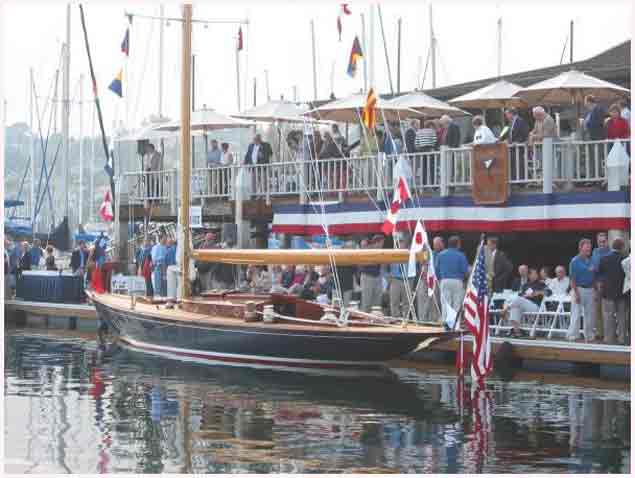 Cotton Blossom II after restoration by Johnny Smullen
Cotton Blossom II after restoration by Johnny Smullen
Inspired by Jack Brennan and other master craftsmen, Johnny has gone on to become a shipwright of such skill from his base in San Diego, California, that he in turn inspires others, one of his most famous projects being the complete restoration of the 49ft Q Class sloop Cotton Blossom II of 1925 vintage.
When a complete restoration is contemplated, Johnny doesn’t mess about. The word is that when he and Dennis turned up to finalise the deal on Cotton Blossom and bring her back to San Diego, they found the previous owners sorry enough to see her go, and rather proud of the style in which they’d maintained her. But after they’d gone to sort the details with the new owner, they went to take a last look at the boat. It’s said they found that Johnny had already delivered his opinion on the existing rig by cutting the shrouds and stays at the deck with bolt-croppers, and cutting the old mast off at deck level with a chainsaw.
Maybe that’s an apocryphal Johnny Smullen from taking delivery of another boat. Yet when you see Cotton Blossom in her restored form, it’s clear what Johnny says should indeed be Holy Writ. This is a project of world standard. But what’s even more remarkable is that despite everything the Sailing Boot Camp at the NYC might have inflicted on him all those year ago, Johnny’s love of boats and sailing is such that he has his own personal sweet classic, the lovely 36ft International One Design Altair. She’s sailed as often as possible, and though he can’t make it back to Dun Laoghaire next month for the Golden Jubilee as there’s very major project under way, Altair will be racing with the San Diego classics under the National Yacht Club burgee.
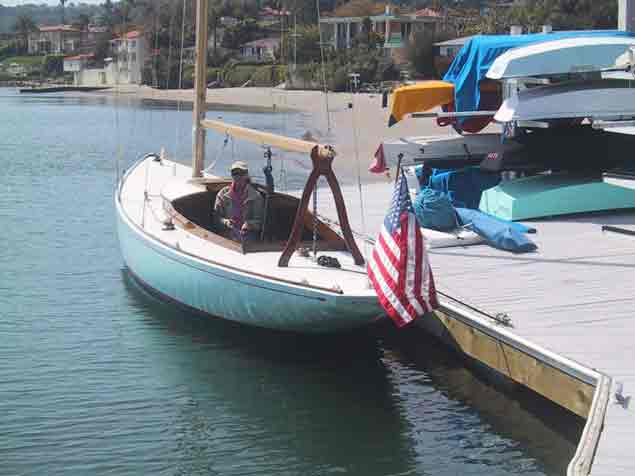 Johnny Smullen’s own pet boat Altair reveals his abiding love of sailing.
Johnny Smullen’s own pet boat Altair reveals his abiding love of sailing.
John Lavery’s father Arthur was another of those pioneering Optimist dads back in the late 1960s, and John and his sister Vivienne were both in that first batch of trainee sailors. He ended up winning championships in more classes then you could quickly count, but the peak of it all came in September 1995 when he and David O’Brien of this parish won the Fireball Worlds in Dublin Bay.
In fact, the graduates from 50 years of a junior training programme at the National YC can be found in successful positions in many boat classes in many places, but it is the club’s outgoing attitude to those who wish to learn to sail which deservedly provided its most outstanding success. A long time ago a Mrs MacAleavey, a widow with no sailing connections, was looking for a club which would make her increasingly boat-mad daughter Cathy – who had recently bought a clapped-out 420 – feel encouraged in any way to learn to sail. Despite the fact that it was still in process of recovering from a fire in the clubhouse, the NYC showed itself the most welcoming along the Dun Laoghaire waterfront, so much so that Mrs McAleavey felt sufficiently encouraged to buy her daughter a new 420, and that in turn led on eventually to Cathy representing Ireland in the women’s 470 in the 1988 Olympics.
The three children she had with husband Con Murphy went on to get their introduction to sailing through the National YC’s junior programme, and daughter Annalise emerged with the talent and the burning ambition which resulted in a heart-breaking fourth at the 2012 Olympics in the Women’s Laser Radial when a medal had seemid almost certainly within her grasp. But memories of that were entirely laid to rest with the Silver Medal in the 2016 Olympics Rio after a difficult final race in which the lone sailor seemed to stay as cool as you please, while the nation at home watched with bated breath.
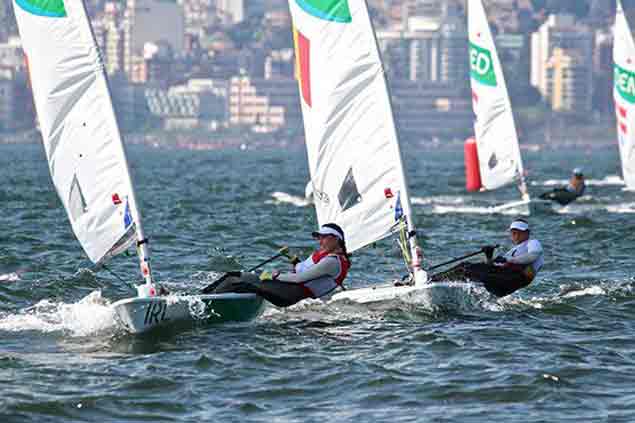 The medal-winning moment as Annalise Murphy crosses the finish line in Rio to win Silver.
The medal-winning moment as Annalise Murphy crosses the finish line in Rio to win Silver.
That it was ultimately a very personal achievement is something respected by her club, and they claim to have done nothing more than provide the first steps on the pathway, and a general spirit of encouragement. But nevertheless the success is all of a piece with the Golden Jubilee which will be celebrated on May 20th, and Carmel Winkelmann continues in her mission of providing a background of training for young sailors of all types, whether they aim only to be a competitive club sailor, or whether they aim for the ultimate heights.
Thus one of her projects in recent years was to find real support for young Finn Lynch, who had reached that difficult stage of being a top junior sailor, yet still had to find his feet as an adult. Thanks to support raised by Carmel, he became Ireland’s representative in the Men’s Lasers at Rio despite going through the final stages of the selection with a training injury recovery problem which may have had an adverse effect on his performance in as the youngest sailor in Rio, aged just 20.
Whether or not he would have been better off not being in Rio at all is neither here nor there. When you’re 20, four years can seem an appallingly long time. The Tokyo Olympics in 2020 must have seeemed aeons away for a young sailor who had shown many flashes of real talent. It was better for him to be in Rio while learning a lot, rather than kicking his heels in frustration in some dead end. And when he needed material help to see through the campaign, it was Carmel Winkelmann who was there to make to ensure that support was available. That will be something else for celebration on May 20th.
 Carmel Winkelmann and Finn Lynch at the National Yacht Club, June 2016. Photo W M Nixon
Carmel Winkelmann and Finn Lynch at the National Yacht Club, June 2016. Photo W M Nixon
Howth Yacht Club’s annual 'Brassed Off' Cup for Optimist Sailors wil be held on the traditional day of Good Friday, 14th April. This fun Optimist dinghy event is designed as a great opportunity for junior racers to dust off their gear and get sailing on the safe waters just north of Howth harbour.
The event has been building into a popular and well attended one over the past few years with more than 60 Main & Regatta Fleet sailors from across Dublin being expected to take part.
Three short races are planned from 12 noon and the Notice of Race and Sailing Instructions are available here.
Not content with hydrofoiling Moths, Laser dinghies or Mini Transat keelboats, the flying craze hits junior sailing with the news that Chalmers University of Technology, Gothenburg, Sweden have figured out how to foil an Optimist dinghy.
Seldén has provided the blocks taking Opti sailing to a whole new level.
Hydrofoils are added to lift the boat, decreasing drag and allowing greater speeds. After experimenting and testing in a ship research and development facility in Gothenburg, Sweden, the dinghy was tried out at sea for the first time.
Axel Rahm sailed and Seldén Tech dept shot the video.
Five Irish Optimist sailors were in the top five of the UK's Spring Championships last weekend. IOCA UK and The Royal Torbay Yacht Club hosted IOCA UK's first championship of the year in Torquay.
119 sailors competed in the main fleet over the two days, including a team of 24 sailors from Ireland. The sailing conditions were deemed "exceptionally tricky", with gusts of over 25 knots and waves of up to two metres.
Overall winner was Jamie Cook of Cardiff Bay Yacht Club, winning five out of the six races, followed by Finley Dickinson in 2nd place and William Pank in 3rd place. Top girl was India Page-Wood in 5th place. First Junior was Luke Turvey from Ireland, who finished a respectable 20th overall.
Top Irish boat was Justin Lucas of Royal Cork in eigth place and his clubmate Killian O'Regan was ninth. Full results are here.
Jamie Cook said: "It's nice to do more events on the sea in a great venue like Torbay and the conditions were awesome. I think that the sea is the best place to sail. It was a good weekend and hope to sail there again soon."
29 regatta fleet sailors completed 10 races over the weekend with Noah Evans from Royal Victoria Yacht Club finishing in 1st place.
IOCA's Claire Mueller added: "A special mention must also be made of Michael Crosbie from Royal Cork Yacht Club, who finished in 15th place and was competing in his first major competition since breaking both legs last year. Well done Michael." In recognition of this achievement Michael received a sailing watch from one of IOCA UK's class sponsors IBI Sailing.
2017 is a special year for IOCA UK, as it has recently been announced it will host a Champion of Champions Race at its 2017 British Nationals in celebration of 70 years of the Optimist Dinghy. To be held at the Weymouth and Portland National Sailing Academy, those battling it out for the ultimate glory will be past National Optimist Champions, Olympic sailors, Optimist coaches and the top current sailors.
World Sailing’s Gold Medal for Ireland’s Helen Mary Wilkes
A lifetime of enthusiastic and effective dedication to voluntary work in international sailing administration has very deservedly resulted in the award of World Sailing’s Gold Medal to Ireland’s Helen Mary Wilkes writes W M Nixon.
She is originally from Scotland while her husband Robert is from England. But when they settled in Ireland in 1969, Howth became their home, sailing became their family sport, and both their sons Tom and Rupert sailed – and still sail - for Ireland.
However, the fact that Helen Mary and Robert together provided a brilliant administrative and creative team was quickly recognized locally and nationally, and it was recognition which became international when Howth Yacht Club took on the staging of the Optimist Worlds in 1981.
 Wall-to-wall Optimist dinghies from dozens of countries at the Worlds in Howth in 1981 – this is how it looks in a double-page spread in the HYC Centenary History, published 1995
Wall-to-wall Optimist dinghies from dozens of countries at the Worlds in Howth in 1981 – this is how it looks in a double-page spread in the HYC Centenary History, published 1995
That would be a relatively straightforward business with today’s modernized facilities. But Howth in 1981 was in the throes of harbour re-development, yet bits of it still functioned as both a sailing and fishing port.
Thus the staging of the worlds was based on the beachside Claremont Hotel immediately west of the Harbour (it has long since disappeared into a large complex of up-market apartments), and much of the running of this huge event had to be developed from scratch.
But with Helen Mary Wilkes in the key position as Secretary to the Organising Committee and Robert in several other roles, the racing for hundreds of Optimists - in what was then the most international sailing event ever seen in Ireland - was successfully completed. The overall winner was Guido Tavelli of Argentina, while the top girl (and best Irish at 17th overall) was 13-year-old Denise Lyttle of the National YC.
 Helen Mary Wilkes (centre) with Viggo and Edith Jacobsen, the founders in 1962 of the International Optimist Dinghy Association, at a major regatta in 1990
Helen Mary Wilkes (centre) with Viggo and Edith Jacobsen, the founders in 1962 of the International Optimist Dinghy Association, at a major regatta in 1990
For most folk in Howth, that was enough involvement in international sailing administration until the new HYC marina and clubhouse were fully functional by 1987. But Helen Mary and Robert Wilkes had been spotted by the powers-that-be as talents that could usefully be deployed on the world stage, and Helen Mary’s subsequent rise through the global and national ranks of sailing administration has been so all-encompassing that it’s best summarized in a basic list:
International Sailing Federation (now World Sailing)
1982 - 1998 International Classes Committee
1990 - 1994 CPOC
1994 - 1998 Events Committee
1994 - 1998 Vice-chair, International Classes Committee (elected)
1998 - 2000 Match Racing Committee
2006 & 2008 Nominated for IOC Women & Sport Award
2008 ISAF President’s Development Award (jointly)
2008-2016 Vice-chair, ISAF Classes Committee
International Optimist Class
1978 - 1982 Secretary, IODA of Ireland
1982 - 1987 President, IODA of Ireland
1982 - 1985 Regatta Committee, IODA
1985- 1989 Vice-President
1989 - 1998 President
During that presidency the Class became the largest in the world:
- national membership rose by 78% to 87 countries
- participation at international events rose by 50% to 57 countries
1998 - 2005 Member of Honour
2005 - President of Honour
Match Racing
In 1996 Helen Mary was asked by Paul Henderson (ISAF President) to promote women’s match-racing towards Olympic status and became the first president of the Women’s International Match-Racing Association. The number of active teams and countries increased by nearly 50%.
Irish Sailing Association
1990 - 1998 Council
1992 - 2000 Olympic Committee/Group
World Sailing
March 2017 Gold Medal awarded to Helen Mary Wilkes by newly-elected World Sailing President Kim Andersen
While Helen Mary Wilkes’ many significant roles have made her the more prominent of this remarkable couple, Robert has been busy behind the scenes, and among other things - in addition to being Secretary for 35 years to the International Optimist Class Association - in 2007 he produced a profusely-illustrated history of the first sixty years of this incredibly successful little boat, with additional input from Clifford McKay Jr, who was the first Opty sailor in Florida way back in 1947.
 Helen Mary and Robert Wilkes on being inducted into the Irish Sailing Association’s Hall of fame in 2009
Helen Mary and Robert Wilkes on being inducted into the Irish Sailing Association’s Hall of fame in 2009
Being the sons of such busy and interesting parents made for a special up-bringing for Tom and Rupert. It’s all of a piece that Tom should be involved on the technical side of sailing – he runs a carbon spar-making business in the Netherlands which, in honour of home, he calls Ceilidh Composites. As a result he is a veteran of several Fastnets and Sydney-Hobarts. Rupert has elected to work ashore, but it’s something equally interesting – he restores classic and antique buildings.
However, this week it’s their parents and their enormous contribution to national and international sailing which is deservedly top of the agenda. Our heartiest congratulations to Helen Mary Wilkes on her newly-awarded World Sailing Gold Medal.
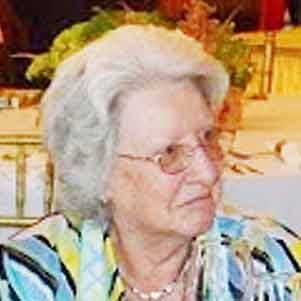 Gold Medallist. Helen Mary Wilkes today
Gold Medallist. Helen Mary Wilkes today
2017 Optimist British National & Open Championships to Host 'Ultimate' Optimist Race
IOCA UK announces it will host a Champion of Champions Race at its 2017 British Nationals in celebration of 70 years of the Optimist Dinghy.
To be held at the Weymouth and Portland National Sailing Academy, this invitation only event will celebrate the 70th Anniversary of the Optimist, first designed in 1947. Those battling it out for the ultimate glory in an optimist dinghy will be past National Optimist Champions, Olympic sailors, Optimist coaches and the top current sailors.
Race organiser Chris Evans explained: "The Optimist boat and Optimist events are the starting point for many sailing stars and 85% of Olympic sailing champions worldwide. In celebration of this special anniversary, we want to capture the spirit of fun, friendship and fierce competition within the Optimist class. Anyone could win the race, whatever their size or age!"
The Champion of Champions race is scheduled to take place on Tuesday 1st August, following racing that day.
The 2017 Volvo Gill Optimist British National and Open Championships take place from 29 July - 4 August 2017 and will welcome over 400 sailors and their families from across the UK and rest of the world.
140 Sign–Up For Optimist Baltimore Spring Training Week 2017
The traditional Optimist Baltimore Spring Training Week event, one of the top International sailing clinics in Europe, takes place next week.
Baltimore Week is Ireland’s largest sailing camp and this year has seen over 140 Optimist sailors from 8 – 15 yrs old sign up for the event.
It is an action packed week of fun for all the family. This event is about making friends and having fun on and off the water in a safe environment.
A team of International coaches from Greece, & Poland are joined by top Irish coaches to provide training for sailors of all competencies, from those who have only recently started to sail to those who are competing internationally.
The week is very much a family-oriented event, with a programme of activities for children too young to sail, and events also organised for adults, such as the ‘How to Rig an Oppi’ class for novice parents! Schull & Fitbones provides activities for those 5 years and upwards who are not yet sailing. They do Baltimore Treasure Hunt and Playground games, Sherkin Island trip and an Adventure Challenge in Lough Hyne Woods.
Evening activities are also on offer, including the ever-popular cinema night and also a disco night. In addition the week finishes off with a one day regatta which helps sailors consolidate all they have learnt during the week & to put it into practice.
The annual event is hosted by Baltimore Sailing Club, which is set in the beautiful harbour of Baltimore, West Cork.
IODAI Forum 2017
An IODAI forum takes place during the Baltimore week where all parents are invited to express their views or seek information on the running of the Optimist class.
Tralee Bay Maritime Hosts Inaugural Dinghy Race Clinic
Tralee Bay Maritime Centre have over 50 boats on the water this week at Fenit in County Kerry. Brian O'Sullivan, Centre Principal, told Afloat.ie he is delighted with the response to the performance coaching clinic, led by Thomas Chaix, with some of the best junior sailors in the country coming together in three different dinghy sailing classes - Lasers, Toppers and Optimists.
Coaches from Greece, Portugal, France, Poland and Ireland have their hands full with a massive turnout for the inaugural clinic at Europe's most westerly port.
Irish Optimist Nationals for Royal Irish Yacht Club, Youth Class Publishes 2017 Calendar
The Irish Optimist class has published its 2017 calendar highlighting the youth boat's national championships at the Royal Irish Yacht Club as the season's penultimate fixture from August 17 to 20.
February kicks off the season with the Baltimore Sailing Club Spring Training Week from February 19 to 24 before April IODAI trials commence at Ballyholme Yacht Club on April 20-23.
Download the full calendar below.


























